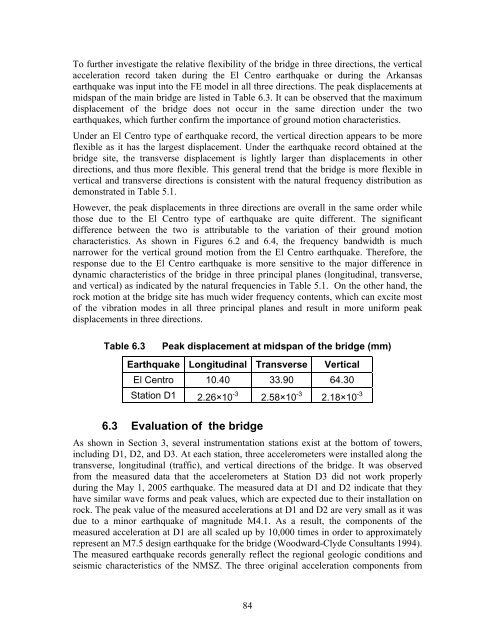Assessment of the Bill Emerson Memorial Bridge - FTP Directory ...
Assessment of the Bill Emerson Memorial Bridge - FTP Directory ...
Assessment of the Bill Emerson Memorial Bridge - FTP Directory ...
- No tags were found...
You also want an ePaper? Increase the reach of your titles
YUMPU automatically turns print PDFs into web optimized ePapers that Google loves.
To fur<strong>the</strong>r investigate <strong>the</strong> relative flexibility <strong>of</strong> <strong>the</strong> bridge in three directions, <strong>the</strong> verticalacceleration record taken during <strong>the</strong> El Centro earthquake or during <strong>the</strong> Arkansasearthquake was input into <strong>the</strong> FE model in all three directions. The peak displacements atmidspan <strong>of</strong> <strong>the</strong> main bridge are listed in Table 6.3. It can be observed that <strong>the</strong> maximumdisplacement <strong>of</strong> <strong>the</strong> bridge does not occur in <strong>the</strong> same direction under <strong>the</strong> twoearthquakes, which fur<strong>the</strong>r confirm <strong>the</strong> importance <strong>of</strong> ground motion characteristics.Under an El Centro type <strong>of</strong> earthquake record, <strong>the</strong> vertical direction appears to be moreflexible as it has <strong>the</strong> largest displacement. Under <strong>the</strong> earthquake record obtained at <strong>the</strong>bridge site, <strong>the</strong> transverse displacement is lightly larger than displacements in o<strong>the</strong>rdirections, and thus more flexible. This general trend that <strong>the</strong> bridge is more flexible invertical and transverse directions is consistent with <strong>the</strong> natural frequency distribution asdemonstrated in Table 5.1.However, <strong>the</strong> peak displacements in three directions are overall in <strong>the</strong> same order whilethose due to <strong>the</strong> El Centro type <strong>of</strong> earthquake are quite different. The significantdifference between <strong>the</strong> two is attributable to <strong>the</strong> variation <strong>of</strong> <strong>the</strong>ir ground motioncharacteristics. As shown in Figures 6.2 and 6.4, <strong>the</strong> frequency bandwidth is muchnarrower for <strong>the</strong> vertical ground motion from <strong>the</strong> El Centro earthquake. Therefore, <strong>the</strong>response due to <strong>the</strong> El Centro earthquake is more sensitive to <strong>the</strong> major difference indynamic characteristics <strong>of</strong> <strong>the</strong> bridge in three principal planes (longitudinal, transverse,and vertical) as indicated by <strong>the</strong> natural frequencies in Table 5.1. On <strong>the</strong> o<strong>the</strong>r hand, <strong>the</strong>rock motion at <strong>the</strong> bridge site has much wider frequency contents, which can excite most<strong>of</strong> <strong>the</strong> vibration modes in all three principal planes and result in more uniform peakdisplacements in three directions.Table 6.3Peak displacement at midspan <strong>of</strong> <strong>the</strong> bridge (mm)Earthquake Longitudinal Transverse VerticalEl Centro 10.40 33.90 64.30Station D1 -32.26×106.3 Evaluation <strong>of</strong> <strong>the</strong> bridge-32.58×10 2.18×10 -3As shown in Section 3, several instrumentation stations exist at <strong>the</strong> bottom <strong>of</strong> towers,including D1, D2, and D3. At each station, three accelerometers were installed along <strong>the</strong>transverse, longitudinal (traffic), and vertical directions <strong>of</strong> <strong>the</strong> bridge. It was observedfrom <strong>the</strong> measured data that <strong>the</strong> accelerometers at Station D3 did not work properlyduring <strong>the</strong> May 1, 2005 earthquake. The measured data at D1 and D2 indicate that <strong>the</strong>yhave similar wave forms and peak values, which are expected due to <strong>the</strong>ir installation onrock. The peak value <strong>of</strong> <strong>the</strong> measured accelerations at D1 and D2 are very small as it wasdue to a minor earthquake <strong>of</strong> magnitude M4.1. As a result, <strong>the</strong> components <strong>of</strong> <strong>the</strong>measured acceleration at D1 are all scaled up by 10,000 times in order to approximatelyrepresent an M7.5 design earthquake for <strong>the</strong> bridge (Woodward-Clyde Consultants 1994).The measured earthquake records generally reflect <strong>the</strong> regional geologic conditions andseismic characteristics <strong>of</strong> <strong>the</strong> NMSZ. The three original acceleration components from84
















